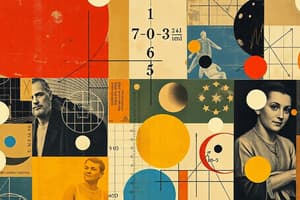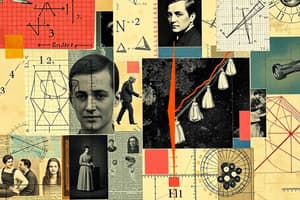Podcast
Questions and Answers
Which measure of central tendency represents the middle value in a data set when arranged in order?
Which measure of central tendency represents the middle value in a data set when arranged in order?
- Range
- Median (correct)
- Mean
- Mode
Variance is a measure of spread that indicates how data points differ from the mean.
Variance is a measure of spread that indicates how data points differ from the mean.
True (A)
What is the normal distribution in statistics?
What is the normal distribution in statistics?
A symmetric probability distribution where most observations cluster around the central peak and probabilities for values further away from the mean taper off equally in both directions.
In hypothesis testing, the __________ is a statement that there is no effect or no difference.
In hypothesis testing, the __________ is a statement that there is no effect or no difference.
Match the following statistical terms with their definitions:
Match the following statistical terms with their definitions:
Which of the following operations is NOT part of arithmetic?
Which of the following operations is NOT part of arithmetic?
Geometry only studies 2D shapes.
Geometry only studies 2D shapes.
What is the purpose of algebra?
What is the purpose of algebra?
In the order of operations, the acronym PEMDAS stands for Parentheses, Exponents, _____, Division, Addition, and Subtraction.
In the order of operations, the acronym PEMDAS stands for Parentheses, Exponents, _____, Division, Addition, and Subtraction.
Match the following branches of mathematics with their focus areas:
Match the following branches of mathematics with their focus areas:
What is a polynomial?
What is a polynomial?
The greatest common factor (GCF) is the largest number that divides two or more numbers.
The greatest common factor (GCF) is the largest number that divides two or more numbers.
What is the primary use of statistics?
What is the primary use of statistics?
Flashcards
Mathematics
Mathematics
The study of quantity, structure, space, and change, involving relationships between objects and using symbols to represent them.
Arithmetic
Arithmetic
The branch of math dealing with basic number operations: addition, subtraction, multiplication, and division.
Algebra
Algebra
Extends arithmetic using variables to represent unknown quantities, enabling solving equations.
Geometry
Geometry
Signup and view all the flashcards
Calculus
Calculus
Signup and view all the flashcards
Statistics
Statistics
Signup and view all the flashcards
Variables
Variables
Signup and view all the flashcards
Equations
Equations
Signup and view all the flashcards
Number systems
Number systems
Signup and view all the flashcards
Order of operations
Order of operations
Signup and view all the flashcards
Data Representation
Data Representation
Signup and view all the flashcards
Measures of Central Tendency
Measures of Central Tendency
Signup and view all the flashcards
Measures of Spread
Measures of Spread
Signup and view all the flashcards
Probability & Distributions
Probability & Distributions
Signup and view all the flashcards
Hypothesis Testing
Hypothesis Testing
Signup and view all the flashcards
Mathematical problem-solving
Mathematical problem-solving
Signup and view all the flashcards
Logical Reasoning in Math
Logical Reasoning in Math
Signup and view all the flashcards
Study Notes
Fundamental Concepts
- Mathematics is the study of quantity, structure, space, and change. It involves investigating relationships between objects and using symbols to represent these relationships.
- Key branches of mathematics include arithmetic, algebra, geometry, calculus, and statistics.
- Mathematics uses logic and reasoning to develop theories and solve problems.
Arithmetic
- Arithmetic deals with basic operations on numbers, including addition, subtraction, multiplication, and division.
- It forms a foundation for more advanced mathematical concepts.
- Arithmetic includes topics like:
- Number systems (natural numbers, integers, rational numbers, real numbers, complex numbers)
- Properties of operations (commutative, associative, distributive)
- Order of operations (PEMDAS/BODMAS)
- Prime factorization
- Greatest common factor (GCF) and least common multiple (LCM)
- Decimals and fractions
Algebra
- Algebra extends arithmetic to include variables.
- Variables represent unknown quantities and are essential for solving equations.
- Key concepts in algebra include:
- Equations and inequalities
- Linear equations and graphs.
- Systems of equations
- Exponents and radicals
- Polynomials
Geometry
- Geometry studies shapes, sizes, positions, and properties of objects in space.
- It covers a wide range of topics including:
- Points, lines, angles, and planes
- Polygons (triangles, quadrilaterals, etc.)
- Circles and other curves
- 2D and 3D shapes
- Transformations (translations, reflections, rotations)
- Measurement of angles and distances
- Area and volume calculations
Calculus
- Calculus deals with change and motion.
- It uses limits, derivatives, and integrals to analyze functions.
- Key concepts in calculus include:
- Derivatives and their applications (rate of change, optimization problems)
- Integrals and their applications (area under a curve, volume of solids)
- Applications to physics, engineering, and economics.
Statistics
- Statistics involves collecting, analyzing, interpreting, presenting, and organizing data.
- It helps in drawing conclusions and making predictions based on data.
- Key concepts in statistics include:
- Data representation (tables, charts, graphs)
- Measures of central tendency (mean, median, mode)
- Measures of spread (variance, standard deviation)
- Probability and distributions (normal distribution, binomial distribution)
- Hypothesis testing and statistical inference
Problem Solving
- Problem-solving is central to mathematics.
- It involves identifying the problem, formulating a plan, executing the plan, and evaluating the results.
- Problem-solving skills extend across all areas of math.
Logic and Reasoning
- Mathematics relies on rigorous logical reasoning.
- Mathematical proofs use deductive reasoning to establish the validity of statements.
- Logical arguments are crucial in deriving conclusions and establishing relationships.
Studying That Suits You
Use AI to generate personalized quizzes and flashcards to suit your learning preferences.
Description
This quiz explores the fundamental concepts of mathematics, focusing on the branches of arithmetic and algebra. It covers essential topics such as operations, number systems, and properties of operations. Enhance your understanding of mathematical relationships and problem-solving skills.



